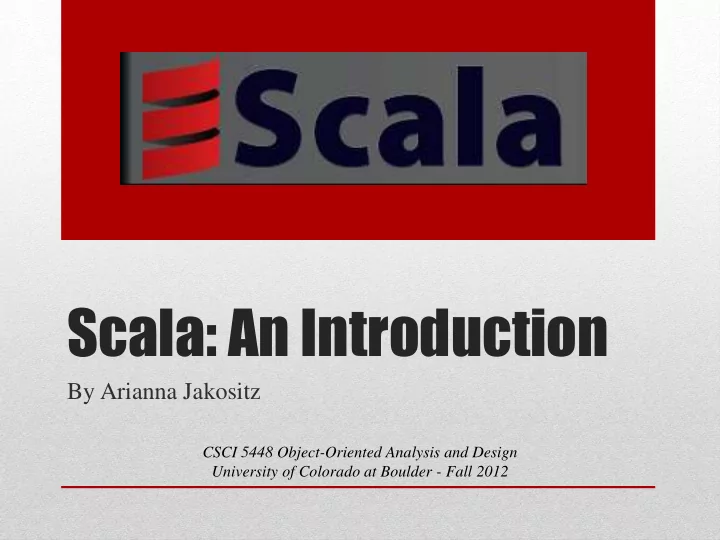

Scala: An Introduction By Arianna Jakositz CSCI 5448 Object-Oriented Analysis and Design University of Colorado at Boulder - Fall 2012
Outline • About Scala • What Is It? • History • Syntax • Object-Oriented Features of Scala • Inheritance • Polymorphism • Encapsulation • Why Use Scala? • Scala vs. Java • Who Is Using Scala? • Resources To Learn More
What’s Ahead: What Is Scala? A Brief History A Look At The Syntax ABOUT SCALA
What Is Scala? • Scala is a mixed programming language, combining features of functional and object-oriented programming aspects Functional because every function is a value Object-oriented because every value is an object Allows users to program effectively in either style according to their needs and desires • Scala runs on the Java Virtual Machine (VM) Java and Scala libraries can directly call each other Byte code compatibility between the two languages • Name comes from the combination of “Scalable” and “Language” Scala is meant to grow (scalability) as user needs evolve
History of Scala • Development began in 2001 by Martin Odersky at the École Polytechnique Fédérale de Lausanne (EPFL) in Lausanne, Switzerland • Created with the intent of improving many of the drawbacks associated with Java. • Martin Odersky initially worked with developers at Sun to add Generics functionality, and improve the compiler, for the Java language • Efforts truly began in the mid-90s on a language known as Pizza, that was eventually scrapped in favor of Scala
A Look At The Syntax of Scala Changing the syntax of Java into that of Scala led to the following modifications: o Built-in type inference, where the compiler deduces type from a variables initialization o Implicit parameters, methods, and conversions o Methods can be used like infix operators (+, -, *, etc.), i.e., 𝑏. 𝑔𝑣𝑜𝑑𝑢𝑗𝑝𝑜(𝑐) can be written as 𝑏 𝑔𝑣𝑜𝑑𝑢𝑗𝑝𝑜 𝑐
Scala Syntax (cont’d) • Variables are declared by the var keyword: [Note: Semicolons are NOT always required] 𝑤𝑏𝑠 𝑦 = 5 • Constants are declared by the val keyword: 𝑤𝑏𝑚 𝑧 = 10 • Types are explicitly declared as follows: 𝑤𝑏𝑠 𝑦: 𝐽𝑜𝑢 = 15 • Functions are declared by the def keyword: [Note: Semicolons are NOT always required] 𝑒𝑓𝑔 𝑔𝑣𝑜𝑑𝑢𝑗𝑝𝑜(𝑦: 𝐽𝑜𝑢, 𝑧: 𝐸𝑝𝑣𝑐𝑚𝑓, 𝑨: 𝐵𝑜𝑧) {… } • Return values of functions are the value of the last line of code contained within the curly braces. If a function is one line, curly braces are not required.
Scala Syntax (cont’d) • Classes are declared with the class keyword: 𝑑𝑚𝑏𝑡𝑡 𝑇𝑝𝑛𝑓𝐷𝑚𝑏𝑡𝑡() {… } • Constructors are not separate methods, but the entire class bodies. Thus, any input parameters to a class can be used right away outside of any explicitly defined method. Overloading the “constructor” is done using calls to this(…), where “…” may refer to any number of input parameters, including 0. • Singleton objects are created by declaring with the object keyword instead of the class keyword: 𝑝𝑐𝑘𝑓𝑑𝑢 𝑇𝑗𝑜𝑚𝑓𝑢𝑝𝑜() {… } • There is no static modifier in Scala! • Abstract classes are declared with the abstract keyword
What’s Ahead : Inheritance Polymorphism Encapsulation OBJECT-ORIENTED SCALA FEATURES
Inheritance and Polymorphism In Scala • Every class inherits from one other class in Scala. When not specifically declared, this class is scala.AnyRef • Inheritance is denoted by the extends keyword: 𝑑𝑚𝑏𝑡𝑡 𝑇𝑣𝑐𝑑𝑚𝑏𝑡𝑡() 𝑓𝑦𝑢𝑓𝑜𝑒𝑡 𝑇𝑣𝑞𝑓𝑠𝑑𝑚𝑏𝑡𝑡 {… } • Overridden methods must be explicitly denoted with the override modifier: 𝑝𝑤𝑓𝑠𝑠𝑗𝑒𝑓 𝑒𝑓𝑔 𝑢𝑝𝑇𝑢𝑠𝑗𝑜() = {… } • Scala classes can also implement from multiple traits, which are like interfaces in Java but can contain code. The implementation of traits is also denoted by the extends keyword. A trait is declared with the trait keyword: 𝑢𝑠𝑏𝑗𝑢 𝑈𝑠𝑏𝑗𝑢𝐸𝑓𝑔𝑗𝑜𝑗𝑢𝑗𝑝𝑜() {… }
Inheritance and Polymorphism In Scala • In order to keep a class from being subclassed, the final modifier may be added to its declaration: 𝑔𝑗𝑜𝑏𝑚 𝑑𝑚𝑏𝑡𝑡 𝐹𝑜𝑒𝑃𝑔𝑈ℎ𝑓𝑀𝑗𝑜𝑓() {… } • Similarly to other object-oriented languages, a subclass can be used in place of an expected superclass in Scala – that is, polymorphism is fully supported in Scala
Encapsulation In Scala • By default, all values in Scala are public • The private modifier can be used to explicitly declare something private • Since every function is a value, and every value is an object in Scala, every value has its own inherent getter and setter. While this initially appears to be a direct access to a class’s fields, the fields can be defined as follows to encourage further encapsulation: private var _field = 1 // Getter: def field = _field // Setter def field_= (value:Int):Unit = _field = value • The underscore character allows the setter to essentially be “field =“
What’s Ahead: Scala vs. Java Who Is Using Scala? WHY USE SCALA?
Scala Compared to Java • Code written in Scala tends to be two to three times shorter than code written in Java. • Scala allows for the following unsupported features in Java: • No backward-compatibility constraints to limit the functional programming capabilities • Unchecked exceptions • Operator overloading • No distinction between primitive types and all other types – all values are objects • No static modifier in Scala
Who Is Using Scala Scala is gaining traction in industry, and being used for many different purposes in many different companies: • Twitter -- The primary messaging queue transitioned from Ruby to Scala, which improved performance and reduced lines of code • LinkedIn – Implemented the Norbert library in Scala, which “provides easy cluster management and workload distribution” [ More] • Sony Pictures Imageworks – Scala Migrations library for database schema management [More] • Xerox – ICE Project, which deals with invitations to Xerox showrooms in the United Kingdom • …And much more
Resources To Learn More • Official Scala website: http://www.scala-lang.org/ • Scala For Java Refugees (blog to help Java developers to transition!) http://www.codecommit.com/blog/scala/roundup-scala-for-java-refugees • Scala For The Impatient by Cay S. Horstmann; 2012, 1 st edition (introduction to Scala for experienced developers) • Another Scala Reference http://www.simplyscala.com/
Recommend
More recommend